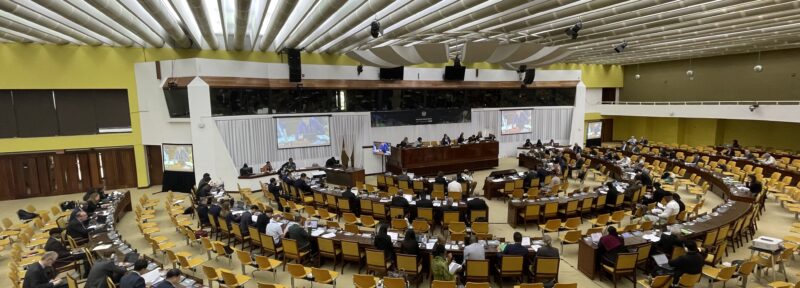What Canada Can Do Next to Protect the High Seas
Yesterday, Canada’s Minister of Fisheries and Oceans signed the High Seas Treaty at the United Nations headquarters in New York. It was one year to the day since countries first agreed on the treaty text: On March 4th, 2023, delegates and civil society celebrated in the early morning hours, with both applause and tears erupting after almost two decades of discussions and formal negotiations. International policy advisor Nicole Zanesco and I were among the civil society participants on the ground who got to see the treaty through to the end—after so many years of starts and stops, watching the world come to an agreement was a significant moment. But as with any big step forward, it is only the start of the next chapter.
Canada has become the 88th country to sign the treaty, demonstrating its intent to work towards a new governance regime for the 50 percent of the planet that makes up the high seas. These vast ocean areas are beyond the borders of any one country, so nations must work together to protect and manage them. The new treaty deals specifically with “biodiversity beyond national jurisdiction,” or BBNJ. It allows marine protected areas to be established, creates a new regime for environmental impact assessments, sets out a framework for accessing and sharing the benefits of marine genetic resources, and requires that developed countries provide the capacity for developing states to participate in high seas research. In addition, the treaty requires that traditional knowledge be used alongside scientific information to advise decision-makers.
But the treaty has yet to come into force; for that to happen, at least 60 countries must also ratify it, meaning that their governments formally recognize the treaty through legislation. Palau and Chile have been the first to do this, and there is an ambitious goal to have the remaining 58 ratifications completed by the next United Nations Oceans Conference in June 2025. This may feel like a big ask, but such ambition is necessary given the many years it took for countries to agree on the text and the increasing threats to high seas biodiversity, from climate change and fisheries to mining and geoengineering.
To recognize this critical moment, Canada hosted a roundtable after the signing to hear from experts and stakeholders. Oceans North participated and sent the message that Canada has every reason to be a champion of the treaty, both at home and internationally. We have a long history of global environmental leadership and are surrounded by three different oceans that we are connected to economically, socially, and culturally. We are party to numerous climate and biodiversity agreements and commitments and have the money and capacity to realize them. As we celebrate Canada signing the treaty, we must also look ahead to how they can make its promise real. It won’t be easy, but Canada has an opportunity to be part of something historic that will benefit future generations.
In the coming year, while geopolitical partnerships are strong, Canada has several opportunities to ensure that the foundations are set for the future health of the high seas. These include supporting other countries in ratifying the treaty, particularly developing states; this could be incorporated into existing policy, such as the country’s Indo-Pacific Strategy. Canada must also work with like-minded states at the International Seabed Authority to ensure that deep sea mining does not start until the full impacts on biodiversity can be understood. To protect areas of the high seas from existing activities, Canada should co-sponsor a proposal at the North Pacific Fisheries Commission this April to limit bottom trawling on the Emperor Seamounts until an updated impact assessment can be completed.
Finally, Canada needs to work with Arctic states and help bring together Arctic Indigenous leaders to discuss governance of the Central Arctic Ocean—a unique and relatively intact ecosystem where industrial activities have yet to start. Indigenous Peoples have often been excluded from international decision-making, and our country has a role to play in changing that.
Attention must also be paid to the connections between oceans and climate. The ocean continues to absorb most of the excess heat generated due to climate change and freshwater from melting in the Arctic and Antarctic. Excess carbon dioxide in the atmosphere is taken in by the ocean, too, causing it to become more acidic. We can’t protect biodiversity without accounting for the shifts that are happening as a result of fossil fuel emissions. Canada must find more ways to reduce its emissions while supporting ocean climate-change proposals in existing high-seas governance entities such as regional fisheries management organizations.
It took over a decade to create the BBNJ Treaty, and even if it is ratified by 2025, it will not come into force immediately. As we celebrate the first anniversary of its completion, it’s gratifying to see Canada recognize the urgency and importance of moving the treaty forward and ensuring there are places left to protect. Moments like this help recapture that sense of hope from one year ago when the world came together and promised to make a positive change for the ocean we all share. Canada now has an important role in making that promise a reality.
Susanna Fuller is Oceans North’s Vice President of Conservation and Projects; Nicole Zanesco is Oceans North’s International Policy Advisor.





